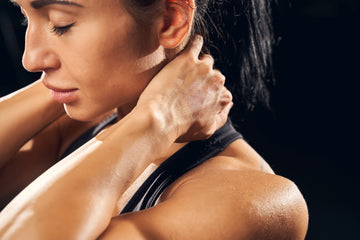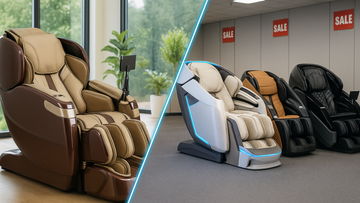Body stiffness is common and often throws a wrench in our day-to-day life. Sometimes, it's just a mild annoyance, but other times, it can be seriously painful and restricts how much a person can move around. By figuring out why body stiffness happens and using the right strategies to deal with it, you can learn how to relieve body stiffness and get your flexibility back on track.
This article will take a closer look at what causes body stiffness and share some great tips on stretching properly, picking the best low-impact workouts, using heat therapy effectively, massaging your way to relief, and changing your daily habits to help keep stiffness away.
The Common Causes of Stiffness in Body Parts
From dozing off sitting up on the couch to "laying the wrong way" in bed, body stiffness creeps into our lives for several reasons. Addressing the common causes of muscle stiffness through targeted strategies can significantly alleviate discomfort and improve flexibility at home.
You may experience body stiffness from::
- Inactivity: Extended periods of physical inactivity, especially in today's sedentary lifestyle, can lead to stiff muscles and joints.
- Poor posture: Incorrect posture while sitting, standing, or sleeping can cause undue stress on certain body parts, leading to stiffness and pain.
- Muscle tension: Stress and anxiety can manifest physically as increased muscle tension, particularly in the neck, shoulders, and back.
- Aging: Our joints and tissues naturally lose elasticity as we age, leading to increased stiffness as well as aches and pains in old age.
- Dehydration: Insufficient fluid intake can cause the tissues to become less pliable, contributing to stiffness.
Stretching Routines and Low-Impact Exercises to Help with Body Stiffness
Incorporating stretching and low-impact exercises into daily routines may help alleviate the discomfort of body stiffness. These actions help to increase muscle elasticity and improve joint mobility – they are great for those who have trouble with mobility or are older.
Targeted Stretches for Problem Areas
Identifying and focusing on problem areas can lead to more effective relief. For instance, if you are experiencing neck, back, or shoulder stiffness, targeted stretches may help eliminate the stiffness in that area.
Lower Back
Pelvic tilts: Start by lying on your back, knees bent, and feet flat on the ground. Slowly arch your lower back upwards, creating a small gap between your back and the floor. Then, gently lower your back down, pressing it flat against the floor. This gentle rocking movement can help relax and release tension in the muscles of your lower back.
Cat-cow stretch: Get on your hands and knees, and switch between curving your spine toward the ceiling (resembling a cat) and lowering it down toward the floor (mimicking a cow). This movement not only helps relieve tension in the lower back but also improves the flexibility of your spine.
Neck and Shoulders
Neck rolls: Lower your chin towards your chest and gently rotate your head in a circular motion. This action helps to release any tension accumulated in the neck area.
Shoulder shrugs: Lift your shoulders towards your ears simultaneously, hold for a few seconds, and then relax them down. Repeat this movement multiple times to help alleviate tension in the shoulders.
Hips and Legs
Pigeon pose: Start kneeling, then move one knee forward while extending the other leg back, lowering your hips toward the ground. This yoga pose is great for stretching the hip flexors and easing tightness.
Hamstring stretch: Stand up and step one foot forward, lifting the toes of that foot, and lean gently forward over the leg that's extended to stretch the hamstrings.
How to Relieve Body Stiffness with Low-Impact Exercises
Low-impact exercises are designed to increase heart rate and build muscle slowly but put limited stress on the joints. They’re particularly beneficial for older people or those suffering from chronic body stiffness.
- Yoga: Yoga helps stretch and strengthen the muscles around the joints. Yoga can also help improve posture and flexibility. Poses like the warrior, tree, and cobra are particularly effective in fighting stiffness in the body.
- Pilates: Pilates focuses on core strength, alignment, and body awareness. These aspects are crucial for reducing stiffness, particularly around the spine and major joints.
- Swimming: Swimming and water aerobics offer resistance without the harsh impact of gravity, making them ideal for stiff muscles and joints. The water's buoyancy supports the body, easing movement and reducing pain.
- Tai Chi: Tai Chi is a form of martial arts known for its slow, deliberate movements, including deep breathing. These moves can enhance flexibility and balance while reducing stress.
Heat Therapy To Relieve Stiffness in Body
Heat therapy is an effective way to relax muscles and improve blood circulation to areas of stiffness, helping with faster recovery and easing pain. A warm bath infused with Epsom salts can significantly alleviate muscle stiffness and soothe bodily aches, providing a comforting and therapeutic experience. Using heating pads on stiff areas can also offer immediate relief. These pads help relax muscles and lessen tightness, making them an excellent choice for quick and targeted pain reduction.
3 Massage Techniques to Help Reduce Body Stiffness
Massage is a direct way to manipulate and relax stiff muscles, improve circulation, and encourage flexibility. There are several ways to bring massage into your home – three of these include tools, self-massage techniques, and even luxury massage chairs.
- Self-massage: Regular self-massage helps to break down tight muscle fibers, release tension, and enhance mobility. It's a convenient method for maintaining muscle health and reducing discomfort, especially for those who may not have the time or resources for professional massage sessions. If self-massage is challenging in certain areas like the back, you can also have a family member, partner, or friend learn back massage techniques to help find relief.
- Massage tools: Foam rollers are popular for their ability to work on large areas like the back, thighs, and calves, helping to soothe muscle tightness and increase circulation. Massage balls provide more localized pressure, making them excellent for deep tissue work on knots and hard-to-reach areas such as the shoulders and feet.
- Massage chair: Different massage chair features like rolling, kneading, and tapping, which help to loosen tight muscles and improve circulation throughout the body. Many models also come with heating options, which enhance the muscle-relaxing effects by promoting blood flow to stiff areas.
How to Get Rid of Body Stiffness with Lifestyle Changes
Small lifestyle changes can significantly reduce body stiffness. Even small changes like drinking more water and staying hydrated can make a big impact; ensuring that the body's tissues and joints are lubricated, reducing stiffness. Staying hydrated is important, especially when doing stretches or low-impact exercises. If you want to enhance your workspace, implementing ergonomic practices can help improve your posture and overall health.
Relieving body stiffness involves understanding the causes and experimenting with different solutions like stretching, low-impact exercises, heat therapy, massage, and lifestyle changes. By incorporating these strategies into daily life, anyone with body stiffness can significantly improve their flexibility, reduce discomfort, and enhance their overall well-being.
Disclaimer: This content is not medical advice. Please consult with your healthcare professional when considering implementing changes to your health or workout routines to ensure it’s compatible with your needs.





